Abstract
1 The effects of the new H2-receptor antagonist famotidine, administered orally, on gastric secretion and emptying as well as on experimentally-induced gastric and duodenal ulcers were studied in the rat. Ranitidine was used as a reference compound. 2 Both compounds inhibited acid secretion in a dose-dependent manner. Calculated ED50 values were 0.80 and 6.84 mg kg-1 for famotidine and ranitidine, respectively. However, the duration of the antisecretory action was the same for both drugs. 3 The effect of the two drugs, administered at equiactive antisecretory doses, on gastric emptying was different. Ranitidine significantly accelerated the emptying rate whereas famotidine had no effect. 4 Famotidine reduced, in a dose-dependent manner, ulcer incidence in stomachs of dimaprit-treated rats and in duodena of cysteamine-treated animals with a potency respectively 2 and 7 times higher than that of ranitidine. 5 Famotidine is therefore an effective antisecretory and untiulcer compound. Its potency, but not its efficacy, is higher than that of ranitidine. Moreover, the duration of the antisecretory action is virtually the same for both drugs.
Full text
PDF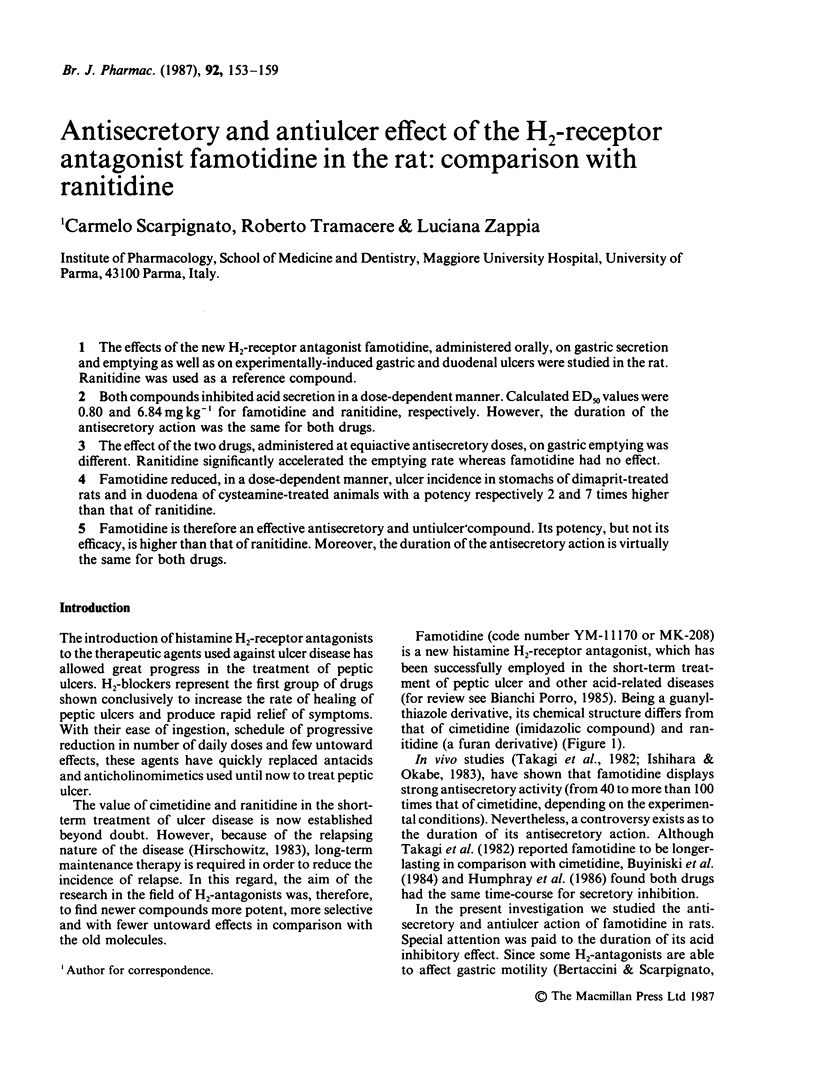
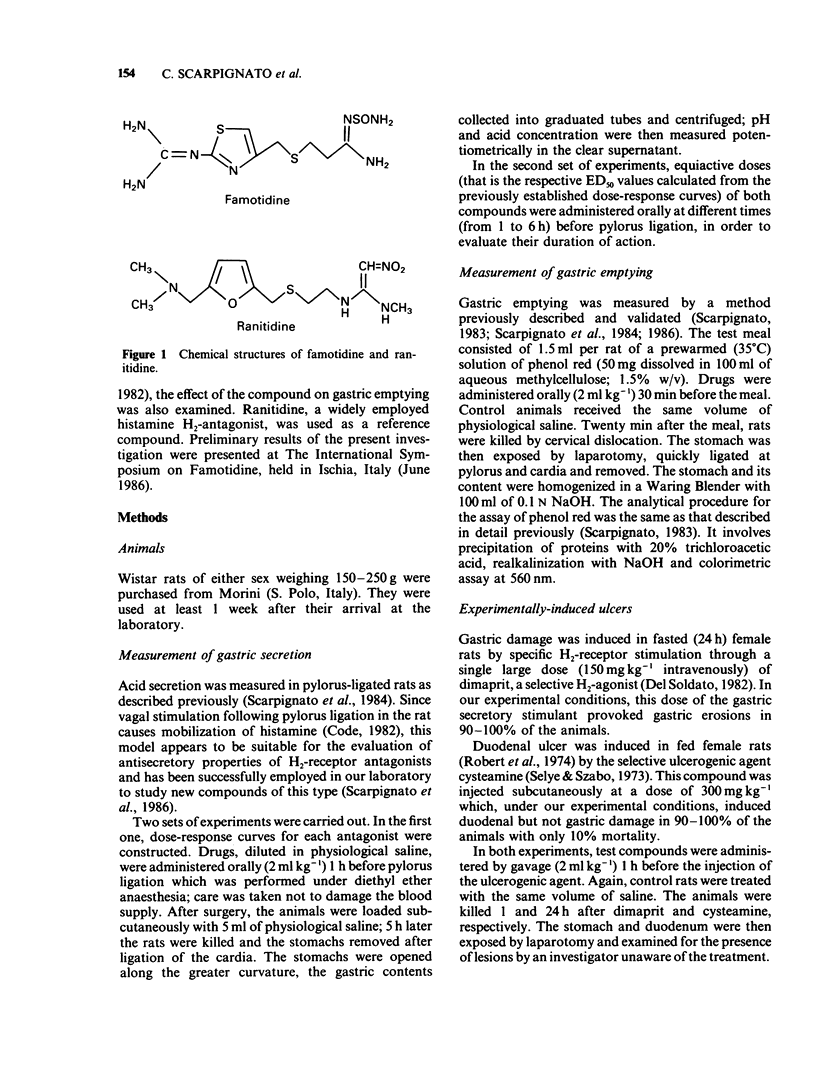
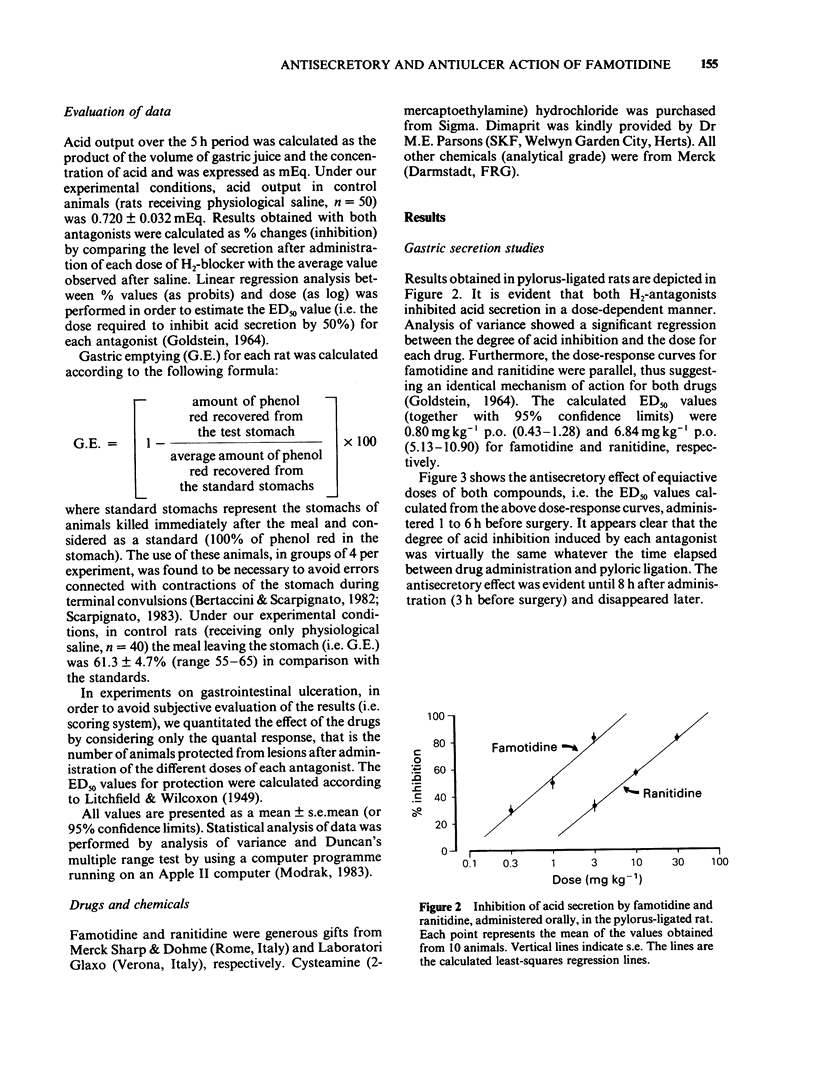
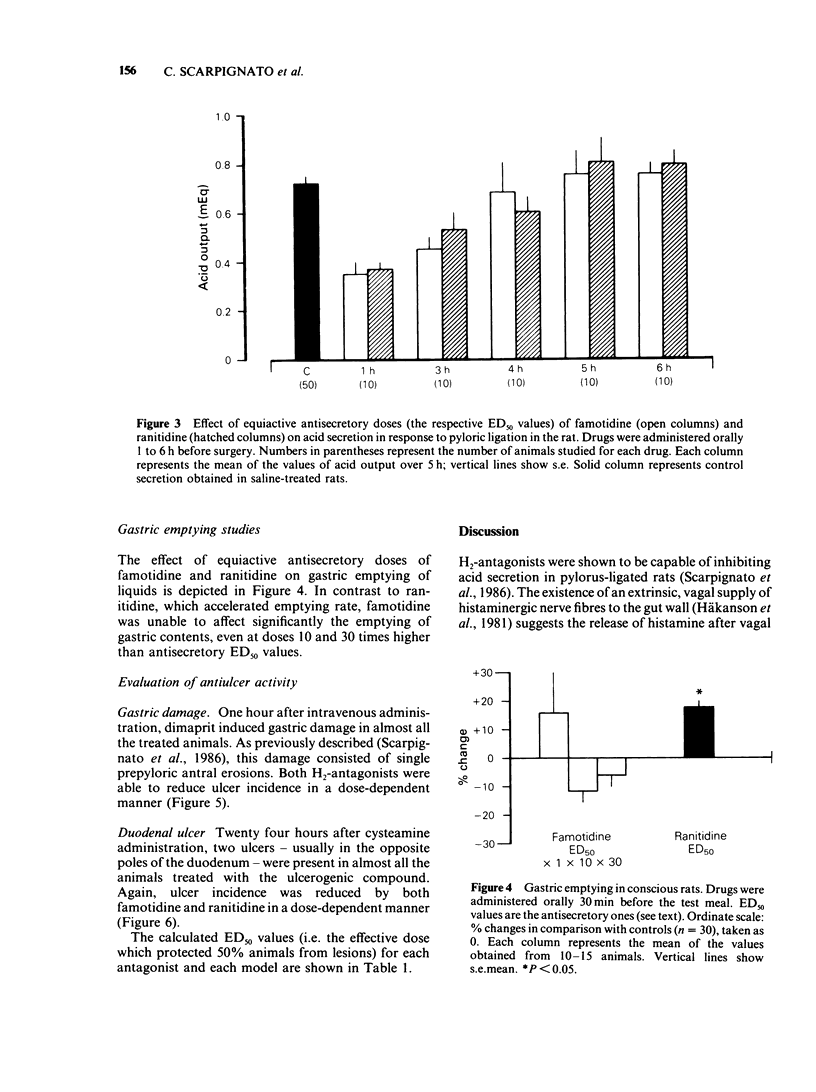
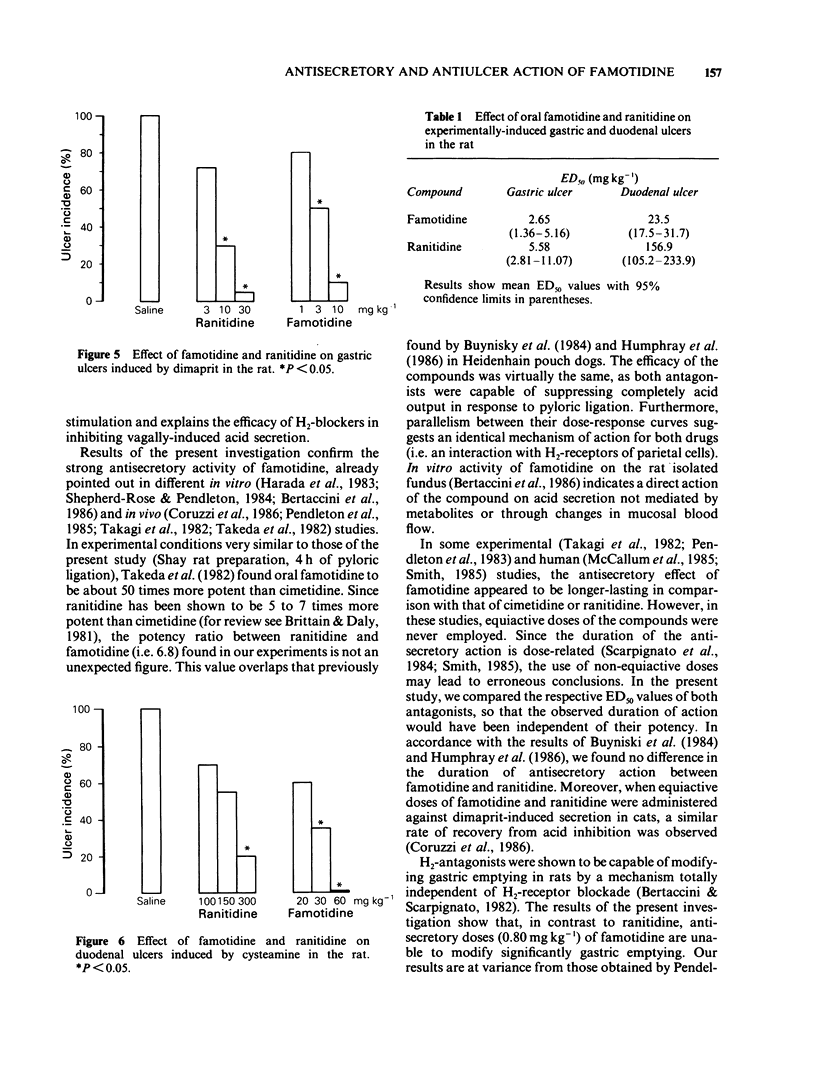
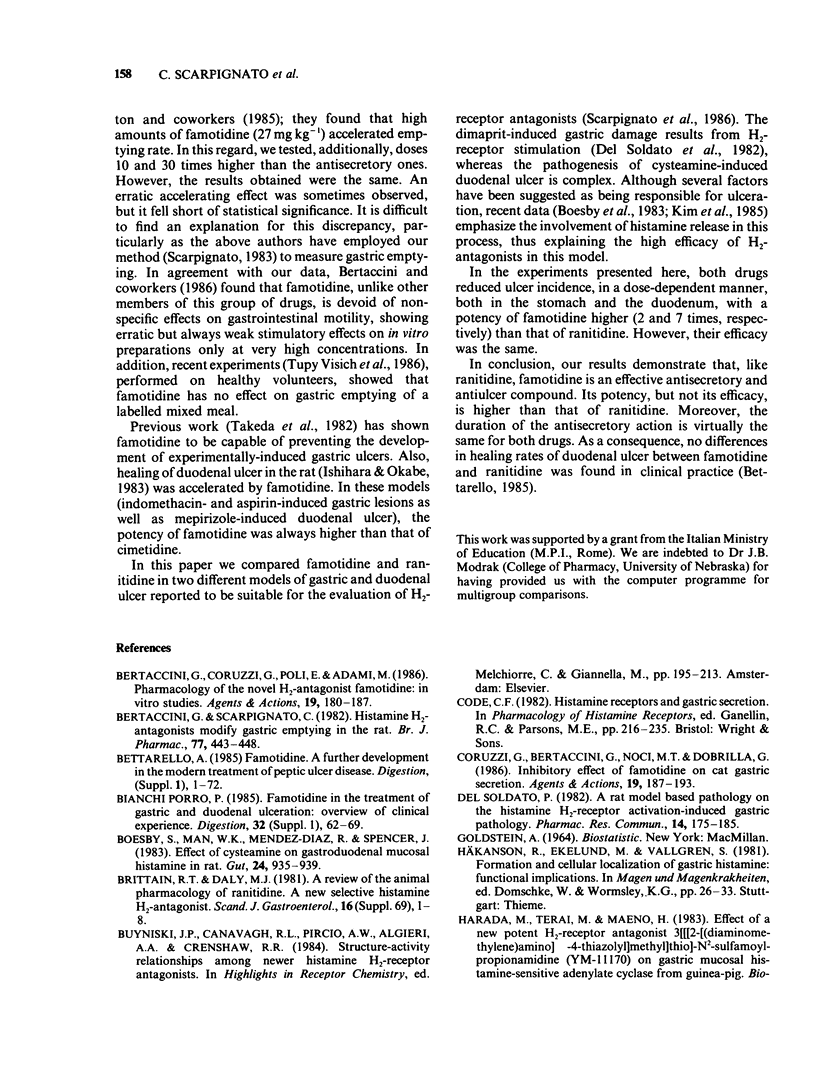
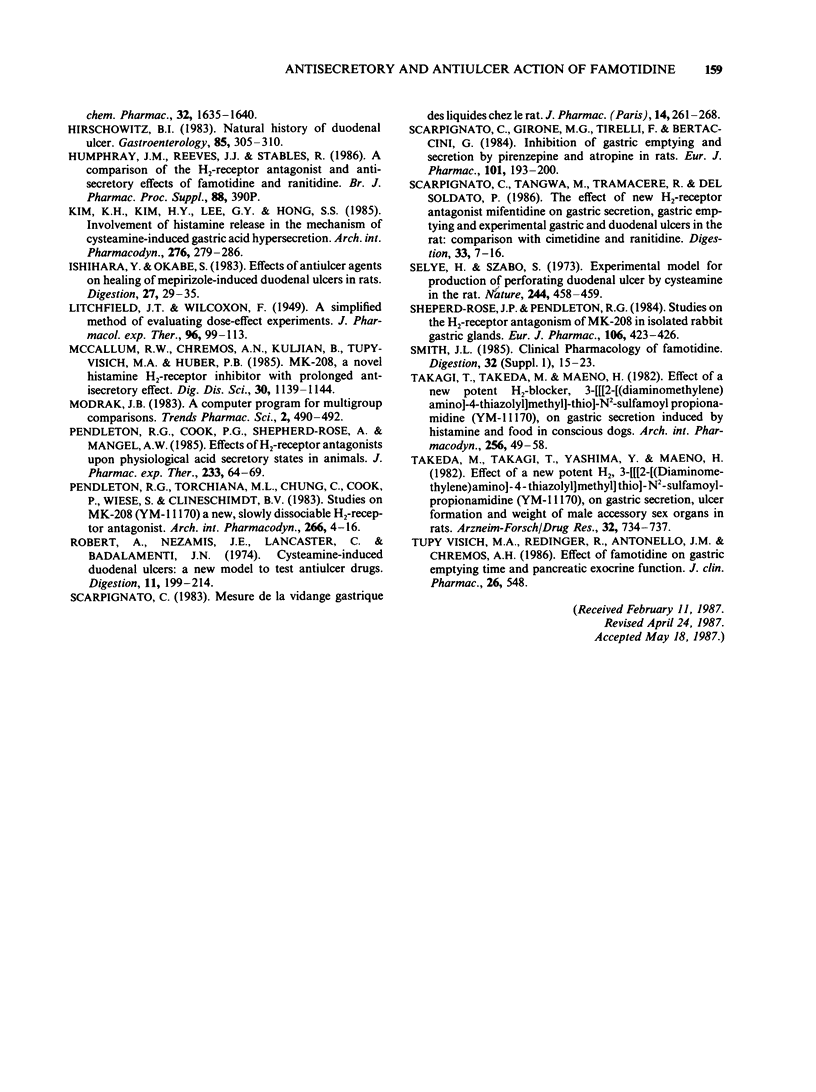
Selected References
These references are in PubMed. This may not be the complete list of references from this article.
- Bertaccini G., Coruzzi G., Poli E., Adami M. Pharmacology of the novel H2 antagonist famotidine: in vitro studies. Agents Actions. 1986 Nov;19(3-4):180–187. doi: 10.1007/BF01966204. [DOI] [PubMed] [Google Scholar]
- Bertaccini G., Scarpignato C. Histamine H2-antagonists modify gastric emptying in the rat. Br J Pharmacol. 1982 Nov;77(3):443–448. doi: 10.1111/j.1476-5381.1982.tb09316.x. [DOI] [PMC free article] [PubMed] [Google Scholar]
- Bianchi Porro G. Famotidine in the treatment of gastric and duodenal ulceration: overview of clinical experience. Digestion. 1985;32 (Suppl 1):62–69. doi: 10.1159/000199264. [DOI] [PubMed] [Google Scholar]
- Boesby S., Man W. K., Mendez-Diaz R., Spencer J. Effect of cysteamine on gastroduodenal mucosal histamine in rat. Gut. 1983 Oct;24(10):935–939. doi: 10.1136/gut.24.10.935. [DOI] [PMC free article] [PubMed] [Google Scholar]
- Brittain R. T., Daly M. J. A review of the animal pharmacology of ranitidine--a new, selective histamine H2-antagonist. Scand J Gastroenterol Suppl. 1981 Jun;69:1–9. [PubMed] [Google Scholar]
- Coruzzi G., Bertaccini G., Noci M. T., Dobrilla G. Inhibitory effect of famotidine on cat gastric secretion. Agents Actions. 1986 Nov;19(3-4):188–193. doi: 10.1007/BF01966205. [DOI] [PubMed] [Google Scholar]
- Del Soldato P. A rat model based on the histamine H2-receptor-activation-induced gastric pathology. Pharmacol Res Commun. 1982 Feb;14(2):175–185. doi: 10.1016/s0031-6989(82)80098-2. [DOI] [PubMed] [Google Scholar]
- Harada M., Terai M., Maeno H. Effect of a new potent H2-receptor antagonist 3[[[2-[(diaminomethylene)amino]-4-thiazolyl]methyl]thio]-N2- sulfamoylpropionamidine (YM-11170) on gastric mucosal histamine-sensitive adenylate cyclase from guinea pig. Biochem Pharmacol. 1983 May 15;32(10):1635–1640. doi: 10.1016/0006-2952(83)90339-8. [DOI] [PubMed] [Google Scholar]
- Ishihara Y., Okabe S. Effects of antiulcer agents on healing of mepirizole-induced duodenal ulcers in rats. Digestion. 1983;27(1):29–35. doi: 10.1159/000198916. [DOI] [PubMed] [Google Scholar]
- Kim K. H., Kim H. Y., Lee G. Y., Hong S. S. Involvement of histamine release in the mechanism of cysteamine-induced gastric acid hypersecretion. Arch Int Pharmacodyn Ther. 1985 Aug;276(2):279–286. [PubMed] [Google Scholar]
- McCallum R. W., Chremos A. N., Kuljian B., Tupy-Visich M. A., Huber P. B. MK-208, a novel histamine H2-receptor inhibitor with prolonged antisecretory effect. Dig Dis Sci. 1985 Dec;30(12):1139–1144. doi: 10.1007/BF01314047. [DOI] [PubMed] [Google Scholar]
- Pendleton R. G., Cook P. G., Shepherd-Rose A., Mangel A. W. Effects of H2-receptor antagonists upon physiological acid secretory states in animals. J Pharmacol Exp Ther. 1985 Apr;233(1):64–69. [PubMed] [Google Scholar]
- Pendleton R. G., Torchiana M. L., Chung C., Cook P., Wiese S., Clineschmidt B. V. Studies on MK-208 (YM-11170) a new, slowly dissociable H2-receptor antagonist. Arch Int Pharmacodyn Ther. 1983 Nov;266(1):4–16. [PubMed] [Google Scholar]
- Robert A., Nezamis J. E., Lancaster C., Badalamenti J. N. Cysteamine-induced duodenal ulcers: a new model to test antiulcer agents. Digestion. 1974;11(3-4):199–214. doi: 10.1159/000197584. [DOI] [PubMed] [Google Scholar]
- Scarpignato C., Girone M. G., Tirelli F., Bertaccini G. Inhibition of gastric emptying and secretion by pirenzepine and atropine in rats. Eur J Pharmacol. 1984 Jun 1;101(3-4):193–200. doi: 10.1016/0014-2999(84)90156-0. [DOI] [PubMed] [Google Scholar]
- Scarpignato C., Tangwa M., Tramacere R., Del Soldato P. The effect of the new H2-receptor antagonist mifentidine on gastric secretion, gastric emptying and experimental gastric and duodenal ulcers in the rat: comparison with cimetidine and ranitidine. Digestion. 1986;33(1):7–16. doi: 10.1159/000199269. [DOI] [PubMed] [Google Scholar]
- Selye H., Szabo S. Experimental model for production of perforating duodenal ulcers by cysteamine in the rat. Nature. 1973 Aug 17;244(5416):458–459. doi: 10.1038/244458a0. [DOI] [PubMed] [Google Scholar]
- Shepherd-Rose A. J., Pendleton R. G. Studies on the H2-receptor antagonism of MK-208 in isolated rabbit gastric glands. Eur J Pharmacol. 1984 Nov 13;106(2):423–426. doi: 10.1016/0014-2999(84)90733-7. [DOI] [PubMed] [Google Scholar]
- Smith J. L. Clinical pharmacology of famotidine. Digestion. 1985;32 (Suppl 1):15–23. doi: 10.1159/000199257. [DOI] [PubMed] [Google Scholar]
- Takagi T., Takeda M., Maeno H. Effect of a new potent H2-blocker, 3-]]]2-[(diaminomethylene)amino]-4-thiazolyl]methyl]-thio]-N2-sulfamoylpropionamidine (YM-11170) on gastric secretion induced by histamine and food in conscious dogs. Arch Int Pharmacodyn Ther. 1982 Mar;256(1):49–58. [PubMed] [Google Scholar]
- Takeda M., Takagi T., Yashima Y., Maeno H. Effect of a new potent H2-blocker, 3-[[[2-(diaminomethylene)amino]-4-thiazolyl]methyl]thio]-N2-sulfamoyl propionamidine (YM-11170), on gastric secretion, ulcer formation and weight of male accessory sex organs in rats. Arzneimittelforschung. 1982;32(7):734–737. [PubMed] [Google Scholar]


